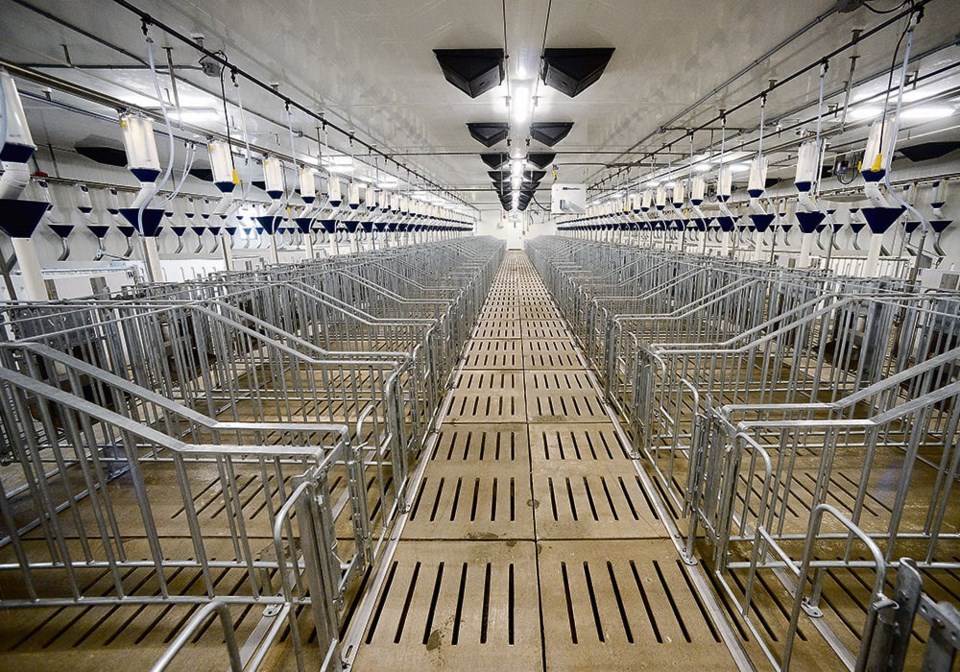WESTERN PRODUCER — There are many options when choosing a loose sow housing system and the decision mostly depends on hog farmers’ confidence in husbandry and technology.
Canadian hog farmers are gradually moving toward loose housing for gestating sows, but debate continues over which system is best.
Matt Davis has tried most of the options — shoulder stalls, electronic sow feeding in several forms and free access stalls. He says they each have positives and challenges.
Davis is vice-president of swine services with Hord Family Farms based in Marion, Ohio.
The company has been working with loose sow housing in large hog farms for almost 20 years.
“How a system works for you, for your team members, for your family, whatever it might be, it’s going to be different,” Davis said at the Southwestern Ontario Pork Conference.
He works for a large system with 30,000 sows in north-central Ohio. The company added another company in southwestern Minnesota last fall that added another 15,000 sows. All but 5,000 are housed in pens.
The Canadian code of practice for care and handling of pigs originally set July 1, 2024, as the deadline for all Canadian sows to have some freedom during gestation. That has been pushed to 2029.
Barn renovation to loose housing is expensive and the resulting barns will house fewer sows, says Davis. That means farmers have to choose between building new, producing fewer pigs or adding to their barns.
In barns where he works, he has seen similar performance between stalls and pens if considering pigs per sow per year, farrowing rate or other important metrics. The best performing farm in his system has sows in pens.
Sows consume about 0.15 percent more feed when housed in loose pens, he says. He attributes the increase to more sow movement, which burns more energy. Some of that extra is paid back because loose sows weigh more when they are shipped to a processor.
Sow death loss is 1.25 percent higher in a pen, which is attributable to an increase in fighting, says Davis. There is no difference in how long sows stay in either system.
“We are able to keep and maintain correct parity structure through all of our farms.”
Success depends on people and their mindset.
“You can take the best guy and if he doesn’t have the right mindset, he won’t be able to do pens.”
Hord Family Farms has tried four different types of pen housing for pregnant sows and has chosen shoulder stalls for most new builds or renovations.
In the shoulder stall system (also called stanchions), the sows are separated by short stalls while they are fed by feed drops. This system is simple and gives sows some protection from others as they are eating.
Their normal sow unit is about 2,500 sows, which are in pens of 10.
“I don’t think 10 is a magic number. It’s what we did on our first farm and stayed with it,” says Davis.
He’s seen farms with groups ranging from six to 40 sows in shoulder stall pens.
Their stalls are about 20 inches long, but some people use 36 or 48 inches.
Davis says his company purposely tried different systems other than shoulder stalls.
“We said if we get the opportunity to do the next pen barn, we’re going to purposely do something different. If we just do stanchions, that’s all we’re ever going to know.”
However, its newest barn, which will produce pigs that qualify for Prop 12 standards in California, also uses shoulder stalls.
Proposition 12 was passed as a ballot referendum in California in 2018. It created strict provisions for sow housing for pork sold in California. Because California’s citizens consume a lot of pork but little pork is produced there, the standards have trickled down to producers across the United States.
The new shoulder stall barn must have 24 sq. feet per sow in loose housing and it limits the time sows can be in a crate. Most barns have 16 to 21 sq. feet per pig.
The new Prop 12 barn built by Hord Farms has pens with space for 12 feeders. If at some point there isn’t a premium for Prop 12-influenced barns, the barn can have a denser sow population.
It also tried free access stalls where sows can enter and exit as they wish. The sows are fed at the front of these stalls. Davis says they’ve measured sow preference and found that 20 percent exit the crates on a regular basis. The other 80 percent go into the stalls and stay there most of the day, protected from their counterparts.
The company has tried two different electronic sow feeding options, in which the sows enter a stall and are fed an individual ration, then leave to mingle with the rest of the herd.
Schauer electronic sow feeders, which are more complex, can feed greater numbers per unit and gather more data. The Schauer units at Hord were removed a couple of years ago due to maintenance issues.
Davis says he knows others who use and like the Schauer units but they didn’t work with the Hord staff and the amount of upkeep needed as units aged.
Sows were in groups of about 80 with the electronic sow feeders. Dividers separated the large group, giving sows a place to curl up and also get away from dominant sows.
The Gestal system is a less expensive and simpler electronic sow feeding system, says Davis.
Sows enter the stalls and are fed from drops that can be customized to their needs. This allows them to be fed according to their period of gestation and body condition.
Davis said the farm reorganized its Gestal systems, which made a difference to performance.

